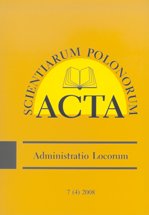OCENA POTENCJAŁU ROZWOJU FUNKCJI TURYSTYCZNEJ
Z WYKORZYSTANIEM METODY TAKSONOMICZNEJ –
STUDIUM WOJEWÓDZTWA WARMIŃSKO-MAZURSKIEGO
AN EVALUATION OF TOURISM POTENTIAL WITH THE USE
OF THE WROCŁAW TAXONOMIC METHOD – A CASE STUDY
OF THE REGION OF WARMIA AND MAZURY
Author(s): Patrycja Szarek-IwaniukSubject(s): Tourism
Published by: Wydawnictwo Uniwersytetu Warmińsko-Mazurskiego w Olsztynie
Keywords: funkcja turystyczna; taksonomia wrocławska; rozwój regionalny; wskaźniki rozwoju turystycznego; regionalizacja
Summary/Abstract: A region’s tourism potential is determined by a variety of natural and anthropogenic factors. The Region of Warmia and Mazury is characterized by considerable tourism potential on account of its diverse land form, unspoiled environment, abundance of forests and lakes. In this article, the tourism potential of the Region of Warmia and Mazury was assessed with the use of the Wrocław taxonomic method which supports multidimensional comparative analyses. Six groups of counties with similar potential for tourism development were identified in the studied region. Their tourism potential was evaluated with the use of four indicators of tourism development: Baretje-Defert’s index, Schneider’s index, Defert’s index and Charvat’s index. The results were compared with values noted for the Region of Warmia and Mazury and Poland. The counties of Mrągowo, Giżycko and Ostróda were characterized by the highest potential for tourism development. Tourism potential was lowest in the western and southern parts of the analyzed region (counties of Nowe Miasto, Nidzica and Działdowo) and in the counties bordering the Kaliningrad Region of the Russian Federation.
Journal: Acta Scientiarum Polonorum Administratio Locorum
- Issue Year: 17/2018
- Issue No: 2
- Page Range: 181-193
- Page Count: 13
- Language: Polish

